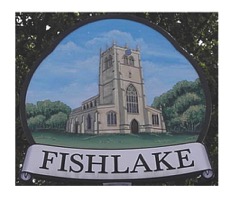or read without illustrations.
The Boating Dike. One of two anomalous man made features, formally part of Fishlake’s ancient landscape.
ONE.
The Boating Dike (warped up) by 1752.
Base on a survey ‘map’ especially drawn up for legal reasons entitled,
‘Survey of the River Dunn from Bramwith to Went’s Mouth’ taken for Lord Irwin by Arthur Scott. Exhibited before a Commission at Thorne in an Exchequer suit between William Simpson and others v Lord Irwin and others. 1752. D/7.
Linked to TN/L 72. Exchequer case re Hatfield and Don Navigation. 1731-8.
Both found at the West Yorkshire Archives at Leeds.
From the 1752 ‘map’ the distance between the Eastern end of The Landing to the Boating Dike 10 chains or 660 feet.
The Northward extent of the Boating Dike is 5 chains or 330 feet, extended through Little Martin Ing which is described as Glebe Land.
1752 Survey above. Thanks to West Yorkshire Archives who have the original.
1891 25 inch OS Map above showing in RED the position of the Boating Dike. Thanks to Ordinance Survey.
1825 Enclosure map showing in RED the former route of the Boating Dike. Thanks to Doncaster City Archives.
Note…See how the buildings are erected either side of the Dike indicating its original position. These were cottages described in 1846 as old and ready for demolition, the brick being used in part to rebuild the Vicarage.
What was the Boating Dike? I have not found any other mention of this landscape feature elsewhere! So the following can only be speculation, the name itself clearly indicates a water course (Dike) and cut to a deep enough and wide enough to allow boats to navigate, even for that relatively short distance. It appears to be open to the tidal river Don allowing boats to enter and exit at suitable times. Maybe it was a safe mooring off the main river for maintenance, loading and unloading goods.
It is worth noting that the original position of the church clock was situated on the South face of the tower until the late 19 th century and described as overlooking the Quay.
ANOTHER LANDSCAPE ANOMALY WORTH GIVING A MENTION.
TWO.
Historic England: Archaeological Data Service have identified a
Group of earthworks, including a possible crew yard, in Fishlake village
‘Probable Medieval or post-Medieval date’. At Grid Reference: SE65411325.
More details: “An examination of air photographs (1a) reveals a group of earthworks at SE 6541 1325 within the village of Fishlake. The earthworks include a number of ditches- possible former boundaries. Also is a sub rectangular hollowed area which may represent the remains of a crew yard. Probable Medieval or Post Medieval”. A crew yard is an open yard for keeping cattle in during winter. Used from the mid-14th century in drier, Eastern, arable counties.
This information was uploaded in 2006.
The location is marked on the map below.
